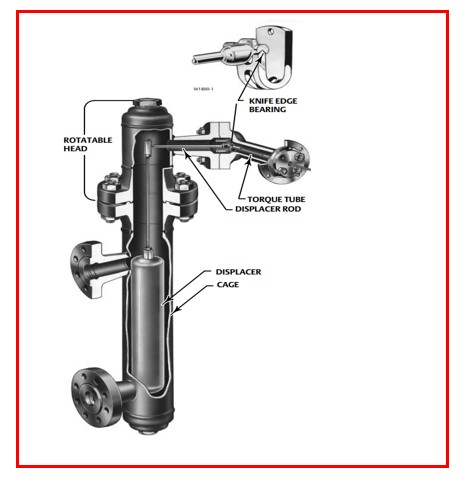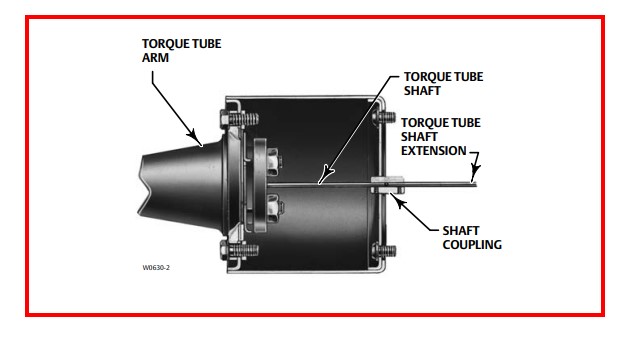Displacer level instruments use the Archimedes Principle to measure the level of a liquid by measuring the weight of a rod that is immersed in the process liquid. As liquid level rises, the displacer rod experiences a greater buoyant force, appearing lighter to the sensing instrument, which interprets the loss of weight as a rise in level and transmits a proportional output signal.


Working of Level Troll:
- A Level troll is an instrument that measures the level of liquid between two known points.
- This level troll instrument is a displacement and torque tube type of instrument.
- The working of level troll is based on the principle of the effect of Buoyancy.
- This level troll is a special instrument used to manage the level of fluid entering the tank by adjusting a level control valve.
- Due to this buoyancy effect, the displacer seems to be lighter than actual when immersed in process fluid or water,
- As the liquid level builds up inside the cage it experiences a larger and larger buoyant force that makes the displacer seems to appear to weigh lighter which relieves some of its weight than actual.
- The lever shifts upwards a little bit that twists the torque tube inside the instrument and this metal rod twists as well bringing the flapper closer to the nozzle building up back pressure this is then amplified by the pneumatic relay which then fills up the bourdon tube and makes to pull away.

- This is a motion balance instrument because the motion of the flapper nozzle is matched by the motion of the bourdon tube.

- The apparent weight of the displacer changes accordingly with respect to the rise or drop of the liquid level.
- This slight twisting motion of the rod is noticed at the end isolated from the pressure of the process fluid.
- A 20 PSI working supply air pressure is continuously provided by an air pressure regulator with filter assembly for the pneumatic level troll.
- The pressure required to fill the bourdon tube becomes a pneumatic output signal of 3 to 15 PSI.
- The sensor may be a torque tube that detects the change in weight and then interpreted it into the fluid level.
- This level troll is attached to a multi-tool proportional controller consisting of a setpoint adjustment, proportional band, and motion balance mechanism for performing proportional loop control.


- The term displacer level troll is known as a float by some people, but actually, the word float is not exact because it will not float on a liquid level instead it hangs within a liquid and experiences a buoyant force proportional to liquid level.

- The mechanism called the torque tube present inside is a spring steel tube that can twist back and forth.
- The lever placed over here upon which the displacer hangs exerts a torque on that tube that twists a small metal rod attached to a flapper and nozzle assembly.
- Level-troll has a float, which is immersed in proportion to raise in liquid level inside the float chamber.
- The amount of immersion of the displacer depends on the density of the process fluid or liquid to develop torque.
- The rate of torque developed is measured in terms of percentage (%) of level.
- Specific gravity is defined as the factor within the process that may affect the span adjustment apart from the length of the fixed displacer
- The displace height extends between two points A and B as shown in the figure above.
Name the various parts of a pneumatic Level troll:
Parts of the pneumatic Level Troll are shown with the diagram below:


- Torque Arm: The torque Arm is a suspension component mounted on a rear-wheel drive axle.
- Torque Rod: The torque Rod is the connection element used to connect the axle to the chassis.

- Torque Tube: Torque Tube is a power transmission system that consists of a large diameter stationary housing between the transmission and rear end to enclose a rotating tubular steel or small-diameter solid drive shaft
- Knife Edge: Knife Edge A piece of steel sharpened to an acute angle resting on a smooth surface functioning as the axis of motion of a pendulum to oscillate with the least possible friction.
- Nozzle: A nozzle is often a pipe or tube of varying cross-sectional area to control the flow of a fluid.

- Nozzle & Flapper: The nozzle and flapper mechanism is a displacement-type detector that converts mechanical movement into a pressure signal by covering the nozzle, These devices work in harsh industrial environments, need little maintenance, and don’t cause an explosive risk in potentially hazardous atmospheres.





